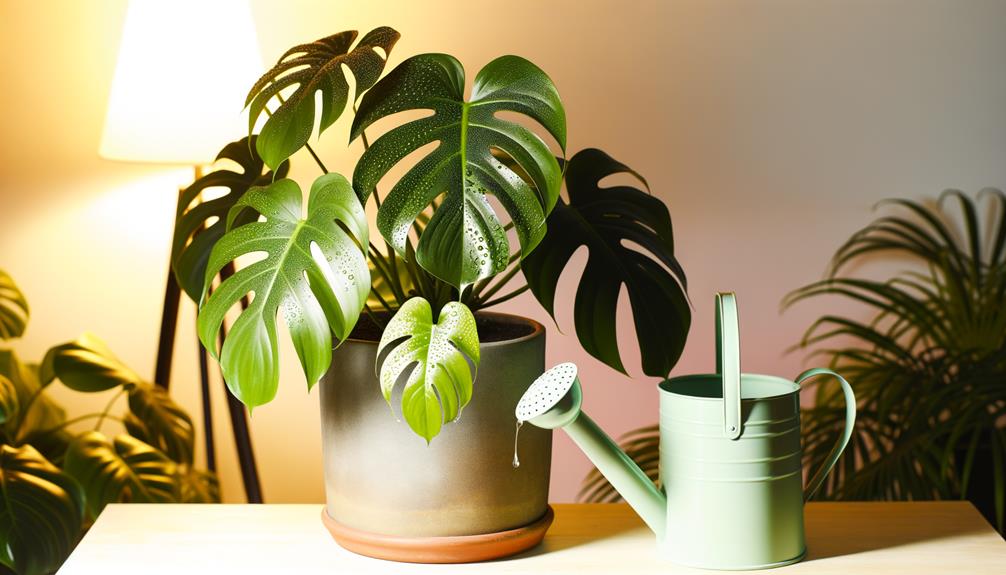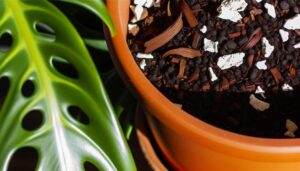Monstera Standleyana Watering Guide
To water your Monstera Standleyana properly, keep its soil moist but it drains well. Let the top inch of soil dry out before you water again.
Avoid overwatering, as it can cause root rot—make sure there's no standing water. In spring and summer, aim to water every 7-10 days; reduce that to every 14-21 days in fall and winter.
Watch for signs like yellowing leaves for overwatering or wilting leaves for underwatering. Consistency is key to maintaining healthy growth, and there's more to explore if you want best results.

Key Takeaways
- Water when the top inch of soil feels dry to maintain optimal moisture levels.
- Ensure the soil is well-draining to prevent root rot and waterlogged conditions.
- Water thoroughly, allowing excess water to drain out completely.
- Increase watering frequency during active growth seasons (spring and summer).
- Reduce watering during fall and winter, aiming for every 14-21 days.
Understanding Water Needs
Understanding the Monstera Standleyana's water needs is vital for ensuring its healthy growth. This plant thrives in moist but well-draining soil, which means it doesn't like to sit in waterlogged conditions. The key is balancing moisture without overwatering.
Monitor the soil's moisture level regularly; the top inch should feel dry before you water again. Environmental factors like humidity and temperature also affect its water requirements. For instance, higher humidity reduces the frequency of watering needed.
Conversely, lower humidity or higher temperatures will necessitate more frequent monitoring and watering. It's important to observe the plant's overall health; yellowing leaves can indicate overwatering, while browning leaf edges suggest underwatering. Understanding these signs helps you tailor your watering routine effectively.
Best Watering Practices
To maximize growth for your Monstera Standleyana, implement best watering practices that cater to its specific moisture needs. Start by using well-draining soil to prevent waterlogging. Check the top inch of soil; if it's dry, it's time to water. Water thoroughly until excess drains out, ensuring even moisture distribution.
Avoid letting the plant sit in standing water, as this can lead to root rot. During the growing season, maintain moderate soil moisture. In winter, reduce watering frequency as the plant's growth slows. Use room-temperature, filtered water to minimize stress from temperature shock or impurities.
Consistency is key—establish a regular watering schedule but always adjust based on environmental conditions and soil dryness.
Signs of Overwatering
One clear sign of overwatering your Monstera Standleyana is yellowing leaves, often accompanied by a mushy texture. When roots sit in waterlogged soil, they can suffocate and rot, leading to these symptoms.
Additionally, you might notice a musty odor emanating from the soil, which indicates root rot. Check for excess water in the saucer beneath the pot, as stagnant water can exacerbate the problem. Overwatering can also cause new growth to appear stunted or distorted.
To prevent this, make sure the plant's pot has proper drainage and wait for the top inch of soil to dry out before watering again. Monitoring these signs allows you to adjust your watering habits and maintain a healthy Monstera Standleyana.
Signs of Underwatering
Wilting leaves and crispy edges are telltale signs that your Monstera Standleyana isn't receiving adequate water. When underwatered, the plant exhibits several distinct symptoms. Look out for:
- Leaf Discoloration: Leaves may turn yellow or brown, starting from the edges and moving inward.
- Stunted Growth: The plant's growth rate will slow down significantly, and new leaves may be smaller than usual.
- Dry Soil: The top layer of soil will be visibly dry and may even pull away from the pot's edges.
Address these signs promptly to prevent further damage. Maintain a consistent watering schedule, allowing the soil to dry slightly between watering. Monitoring these indicators will help you sustain a healthy Monstera Standleyana.
Seasonal Watering Tips
Adjusting your Monstera Standleyana's watering schedule based on the season is essential for its overall health and vigor.
In the spring and summer, when growth is more active, water your plant more frequently, ensuring the soil remains consistently moist but not waterlogged. Aim to water every 7-10 days, depending on your indoor climate.
During fall and winter, reduce watering frequency to about every 14-21 days, allowing the top inch of soil to dry out between waterings.
Always monitor the soil moisture with your finger or a moisture meter to avoid overwatering, which can lead to root rot.
Conclusion
To wrap up, remember that Monstera standleyana needs careful watering—over 70% of indoor plant deaths are due to improper watering. Stick to the best practices we've discussed, and your plant will thrive.
Watch for signs of overwatering and underwatering, and adjust seasonally for best growth. By tuning into your Monstera's needs, you'll guarantee it remains a vibrant, healthy centerpiece in your home.
Proper watering isn't just a task; it's crucial for your plant's survival.






